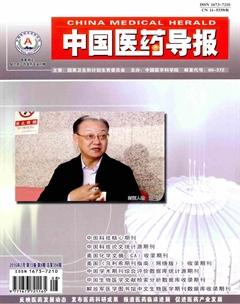非小细胞肺癌的免疫治疗
王紫润 戈伟
[摘要] 肺癌是最常见的恶性肿瘤之一,其中非小细胞肺癌占所有肺癌的85%。虽然靶向治疗使部分晚期非小细胞肺癌(NSCLC)患者获益,仍需要新的治疗方法来针对NSCLC。免疫治疗在黑色素瘤及肾细胞癌中的突出效果,使其成为肿瘤治疗的一种新方法。免疫检查点抑制剂和肿瘤疫苗的研究数据表明,免疫治疗在肺癌治疗中有很大的前景。
[关键词] 非小细胞肺癌;免疫治疗;免疫检查点;肿瘤疫苗
[中图分类号] R734.2 [文献标识码] A [文章编号] 1673-7210(2016)03(b)-0044-04
[Abstract] Lung cancer is one of the most common malignancies worldwide, with more than 85% of cases diagnosed non-small cell lung cancer. Although targeted therapy has led to a significant benefit in a selected group of patients with NSCLC, novel therapeutic approaches are needed. Immunotherapy, which has acquired outstanding efficacy in melanoma and renal cell carcinoma, has been a new method for tumor therapy recently. The data from study of immune checkpoint inhibitors and tumor vaccines suggestes that immunotherapy has a great potential in the treatment of lung cancer.
[Key words] Non-small cell lung cancer; Immunotherapy; Checkpoint inhibitors; Cancer vaccines
肺癌是死亡率最高的恶性肿瘤,转移性肺癌的5年生存率低于5%[1]。肿瘤免疫疗法是继手术、化疗、放疗和靶向治疗之后出现的一种新型的治疗方法,被称为癌症治疗的第五大疗法。它是通过免疫介导杀伤肿瘤细胞的一种治疗方法,其意在通过增强机体的免疫反应或利用各种方法刺激机体免疫系统反应来抵抗肿瘤细胞[2]。近年来,随着免疫治疗的不断发展,取得了许多令人鼓舞的研究成果。本文将全面阐述近年来有关非小细胞肺癌免疫治疗方面的研究进展。
1 免疫检查点抑制剂
免疫检查点是通过调节免疫反应来维持自身耐受并保护周围组织的免疫抑制性通路,肿瘤细胞利用这一特性逃避免疫细胞的攻击[3]。目前肺癌中研究最广泛的两个免疫检查靶点即细胞毒性T淋巴细胞相关抗原4(CTLA-4)和程序性死亡(PD-1)受体。
1.1 CTLA-4
T细胞的活化受多种信号因子的调节。T细胞表面的CD28分子与APCs表面的CD80/CD86发生特异性集合,激活T细胞发挥杀伤肿瘤的效应。但是,T细胞激活后表面高表达的CTLA-4与CD80/CD86结合,阻断T细胞的进一步活化[4]。2011年针对此靶点的药物Ipilimumab获得FDA的批准应用于临床治疗晚期黑色素瘤。Ipilimumab是可与CTLA-4特异性结合的单克隆抗体,能够有效防止CTLA-4与相应配体结合,使肿瘤对相关抗原产生快速的免疫应答[5]。
Salvi等[6]对81名Ⅰ~Ⅲ期非小细胞肺癌(NSCLC)患者进行分析发现在非鳞状上皮组织中CTLA-4过表达,且其表达水平与肿瘤患者预后有一定的关系。Lynch 等[7]对204名患者进行研究发现晚期应用Ipilimumab联合紫杉醇和卡铂可提高NSCLC患者的irPFS和PFS,OS改善无统计学意义。但在亚组分析中发现,鳞癌患者的OS更长,这促进了Ipilimumab在NSCLC中应用的进一步研究。Golden等[8]对一名64岁、有吸烟史的高加索男性肺癌患者应用Ipilimumab联合局部放疗进行治疗,发现不仅肺部局部肿块得以控制,远处转移(肝和骨)也得到惊人的控制,这个案例为放疗联合免疫治疗可能有助于提高晚期转移性肿瘤患者的预后提供了支持。
1.2 PD-1
PD-1是由PDCD1基因编码的1型跨膜蛋白,是T细胞表面重要的抑制性受体。PD-1的配体有PD-L1和PD-L2[9]。受到T细胞攻击的肿瘤细胞高表达PD-L1和PD-L2,并与T细胞上的PD-1受体结合,抑制T细胞的活化,阻碍T细胞对肿瘤的抑制效应,诱导免疫逃逸。目前有关PD1/PD-L1通路的研究主要包括两个方面:一类是与T细胞上的PD-1受体结合,从而抑制肿瘤细胞上的PD-LI与之结合,即PD-1抗体;另一类是抑制肿瘤细胞表面PD-L1蛋白的表达,即PD-L1抗体。在NSCLC中,目前研究的PD-1抗体主要包括nivolumab、pembrolizumab;PD-L1抗体主要包括BMS-936559 (MDX1105)、MEDI4736、MPDL3280A。
Nivolumab(BMS-936558、ONO-4538)是完全的人IgG4单克隆抗体,是针对PD-1免疫检查点的抑制剂,其主要通过干扰PD-1介导的信号通路,恢复T细胞的抗肿瘤免疫效应。Ⅰ期临床研究发现Nivolumab治疗晚期NSCLC(129例)的mOS为9.9个月、RR为17%、中位持续反应时间(DOR)为17个月,总体耐受性较好,3/4级不良反应发生率为14%[10]。Borghaei等[11]比较了Nivolumab和多西他赛对以铂类为基础化疗中或化疗后仍进展的非鳞状NSCLC患者的疗效,发现经铂类为基础的化疗仍进展的晚期非鳞状NSCLC患者,应用Nivolumab治疗较多西他赛患者OS获益更多(12.2比9.4个月)(P=0.002)。随后Brahmer等[12]比较了Nivolumab和多西他赛对以铂类为基础化疗中或化疗后仍进展的晚期鳞状NSCLC患者的疗效(272名),与多西他赛组比较,Nivolumab组的OS改善更加显著(9.2比6.0个月),且差异有统计学意义。基于以上研究,Nivolumab于2015年3月获得美国FDA批准应用于治疗在经铂类为基础化疗期间或化疗后发生疾病进展的转移性NSCLC。
Pembrolizumab(MK-3475,lambrolizumab)是高选择性抗PD-1的人单克隆抗体。Ⅰ期临床试验表明pembrolizumab治疗NSCLC患者常见的不良反应是疲劳、皮肤瘙痒和食欲下降,与用药剂量和方案无显著联系,mPFS为3.7个月,mOS为12.0个月。值得关注的是,在至少50%肿瘤患者中PD-L1的表达与pembrolizumab提高疗效相关[13]。
目前处于临床试验中的PD-L1抗体在治疗NSCLC的亚组分析中ORR从10%(5/49)到23%(12/53),研究者发现既往吸烟或正在吸烟的NSCLC患者对MPDL3280A的治疗反应较从未吸烟患者好(42%比10%,P=0.4229)[14-15]。此外,MPDL3280A治疗反应与肿瘤浸润的免疫细胞表面的PD-L1表达水平相关(P=0.015)[15]。MEDI4736是能与PD-LI特异性结合阻止其与PD-1和CD80结合的人IgG1抗体,在NSCLC的亚组分析中ORR为16%(9/58),12周时DCR为35%[16]。
2 肿瘤疫苗
肿瘤疫苗是通过激活人体的免疫细胞特异性地攻击癌细胞。目前已研发出多种针对NSCLC的疫苗,并进行了大量的临床试验。但在Ⅲ期临床试验中的效果不佳,这可能与肿瘤细胞复杂的免疫逃逸和免疫耐受机制相关。
L-BLP25是针对MUC1的脂质体疫苗,可激发机体产生抗原特异性T细胞免疫应答。Ⅰ期临床试验发现低剂量和高剂量组患者的mOS分别为5.4个月和14.6个月,总体耐受性较好[17]。随后一项ⅡB期临床试验发现与单纯接受最佳支持治疗(BSC)相比,L-BLP25联合BSC的mOS延长了4.2个月(17.2比13.0个月),3年生存率提高了14%(31比17%),且未观察到明显不良反应[18-19]。然而,一项评估L-BLP25作为维持治疗对手术不可切除的NSCLC患者生存期影响的Ⅲ期随机双盲临床试验(START)结果显示虽然L-BLP25治疗组的mOS较安慰剂组延长,但差异无统计学意义(P=0.123)。不过亚组分析发现对既往接受过同步放化疗的患者,L-BLP25治疗组的mOS较安慰剂组延长(30.8比20.6个月),且差异有统计学意义,这一结果需要进一步的研究来证实[20]。
TG4010是一种携带MUC1和IL-2的cDNA的重组病毒疫苗[21]。Ⅰ期临床试验发现在接受TG4010治疗的3例NSCLC患者中有1例表现出显著疗效,且不良反应可耐受[22]。随后进行的Ⅱ期临床试验发现TG4010联合一线化疗(顺铂+长春瑞滨)治疗晚期NSCLC较单用TG4010组的mOS延长(14.9比12.7个月)[23]。Quoix等[24]进行的ⅡB期临床试验结果显示进一步证实了TG4010可增加晚期NSCLC化疗的疗效,TG4010联合化疗组的6个月PFS较单纯化疗(GP方案)组有所提高(43.2%比35.1%)。
MAGE-A3抗原特异性免疫治疗(ASCI)是由重组融合蛋白(MAGE-A3和流感嗜血杆菌D蛋白)和免疫增强辅助系统共同构成。一项评价MAGE-A3辅助治疗可完全切除且MAGE表达阳性的ⅠB/Ⅱ期NSCLC患者疗效的随机双盲Ⅱ期临床试验结果显示,与安慰剂组比较可发现MAGE-A3组治疗的有利趋势,但差异无统计学意义[25]。随后的一项Ⅲ期临床试验(MAGRIT)结果却表明MAGE-A3治疗并未延长MAGE阳性NSCLC患者的DFS[26]。
Belagenpumatucel-L是由4种肺癌细胞株培育出的同种异系细胞疫苗,可促进局部免疫反应,抑制TGF-β2的活性[27]。在Ⅱ期临床试验中发现接种Belagenpumatucel-L疫苗的细胞数量与患者生存率相关,mOS为14.5个月,5年生存率为20%,药物耐受性较好[28]。然而,随后开展的STOP研究发现Belagenpumatucel-L并不能提高一线化疗后无进展NSCLC患者的疗效。但回归分析发现,一线化疗后12周内接受Belagenpumatucel-L治疗和已接受过放疗的患者生存期有所提高,这为进一步研究NSCLC疫苗治疗带来了希望[29]。
3 展望
癌症免疫治疗的研究为NSCLC的治疗提供了新的领域,与传统治疗相比,免疫治疗有其独特的优势。虽然在疫苗研究中取得的结果并不理想,但针对免疫调节检查点如CTLA-4、PD-1和PD-L1的抑制剂在治疗NSCLC中所取得的骄人成果为NSCLC的治疗提供了新的思路。未来免疫治疗所面临的挑战将是靶点的优选性、联合治疗模式的建立及生物标志物预测等。
[参考文献]
[1] Siegel RL,Miller KD,Jemal A. Cancer statistics,2015 [J]. CA Cancer J Clin,2015,65(1):5-29.
[2] Villaruz LC,Kalyan A,Zarour H,et al. Immunotherapy in lung cancer [J]. Translat Lung Cancer Res,2014,3(1):2-14.
[3] Pardoll DM. The blockade of immune checkpoints in cancer immunotherapy [J]. Nature Rev Cancer,2012,12(4):252-264.
[4] Chambers CA,Kuhns MS,Egen JG,et al. CTLA-4-mediated inhibition in regulation of T cell responses: mechanisms and manipulation in tumor immunotherapy [J]. Annual Rev Immunol,2001,19:565-594.
[5] Lipson EJ,Drake CG. Ipilimumab:an anti-CTLA-4 antibody for metastatic melanoma [J]. Clin Cancer Res,2011,17(22):6958-6962.
[6] Salvi S,Fontana V,Boccardo S,et al. Evaluation of CTLA-4 expression and relevance as a novel prognostic factor in patients with non-small cell lung cancer [J]. Cancer Immunol immunother,2012,61(9):1463-1472.
[7] Lynch TJ,Bondarenko I,Luft A,et al. Ipilimumab in combination with paclitaxel and carboplatin as first-line treatment in stage ⅢB/Ⅳ non-small-cell lung cancer:results from a randomized,double-blind,multicenter phase II study [J]. J Clin Oncol,2012,30(17):2046-2054.
[8] Golden EB,Demaria S,Schiff PB,et al. An abscopal response to radiation and ipilimumab in a patient with metastatic non-small cell lung cancer [J]. Cancer Immunol Res,2013,1(6):365-372.
[9] Velcheti V,Schalper KA,Carvajal DE,et al. Programmed death ligand-1 expression in non-small cell lung cancer [J]. Laboratory Invest,2014,94(1):107-116.
[10] Brahmer JR. Nivolumab (anti-PD-1;BMS-936558;ONO-4538) in patients with non-small cell lung cancer (NSCLC):overall survival and long-term safety in a phase 1 trial [J]. J Thorac Oncol,2013(8):S365-S366.
[11] Borghaei H,Paz-Ares L,Horn L,et al. Nivolumab versus Docetaxel in Advanced Nonsquamous Non-Small-Cell Lung Cancer [J]. New England J Med,2015,373(17):1627-1639.
[12] Brahmer J,Reckamp KL,Baas P,et al. Nivolumab versus Docetaxel in Advanced Squamous-Cell Non-Small-Cell Lung Cancer [J]. New England J Med,2015,373(2):123-135.
[13] Garon EB,Rizvi NA,Hui R,et al. Pembrolizumab for the treatment of non-small-cell lung cancer [J]. New England J Med,2015,372(21):2018-2028.
[14] Brahmer JR,Tykodi SS,Chow LQ,et al. Safety and activity of anti-PD-L1 antibody in patients with advanced cancer [J]. New England J Med,2012, 366(26):2455-2465.
[15] Herbst RS,Soria JC,Kowanetz M,et al. Predictive correlates of response to the anti-PD-L1 antibody MPDL3280A in cancer patients [J]. Nature,2014,515(7528):563-567.
[16] Zielinski CC. A phase Ⅰ study of MEDI4736,NNT-PD-L1 antibody in patients with advanced solid tumors [J]. Translat Lung Cancer Res,2014,3(6):406-407.
[17] Palmer M,Parker J,Modi S,et al. Phase I study of the BLP25(MUC1 peptide) liposomal vaccine for active specific immunotherapy in stage ⅢB/Ⅳ non-small-cell lung cancer [J]. Clin Lung Cancer,2001,3(1):49-57.
[18] North S,Butts C. Vaccination with BLP25 liposome vaccine to treat non-small cell lung and prostate cancers [J]. Expert Rev Vaccines,2005,4(3):249-257.
[19] Butts C,Maksymiuk A,Goss G,et al. Updated survival analysis in patients with stage ⅢB or Ⅳ non-small-cell lung cancer receiving BLP25 liposome vaccine (L-BLP25):phase ⅡB randomized,multicenter,open-label trial [J]. J Cancer Res Clin Oncol,2011,137(9):1337-1342.
[20] DeGregorio M,Soe L,Wolf M. Tecemotide (L-BLP25) versus placebo after chemoradiotherapy for stage Ⅲ non-small cell lung cancer (START):a randomized,double-blind,phase Ⅲ trial [J]. J Thorac Dis,2014,6(6):571-573.
[21] Limacher JM,Quoix E. TG4010:a therapeutic vaccine against MUC1 expressing tumors [J]. Oncoimmunology,2012,1(5):791-792.
[22] Rochlitz C,Figlin R,Squiban P,et al. Phase Ⅰ immunotherapy with a modified vaccinia virus (MVA) expressing human MUC1 as antigen-specific immunotherapy in patients with MUC1-positive advanced cancer [J]. J Gene Med,2003,5(8):690-699.
[23] Ramlau R,Quoix E,Rolski J,et al. A phase Ⅱ study of Tg4010 (Mva-Muc1-Il2) in association with chemotherapy in patients with stage Ⅲ/Ⅳ Non-small cell lung cancer [J]. J Thorac Oncol,2008,3(7):735-744.
[24] Quoix E,Ramlau R,Westeel V,et al. Therapeutic vaccination with TG4010 and first-line chemotherapy in advanced non-small-cell lung cancer: a controlled phase 2B trial [J]. Lancet Oncol,2011,12(12):1125-1133.
[25] Vansteenkiste J,Zielinski M,Linder A,et al. Adjuvant MAGE-A3 immunotherapy in resected non-small-cell lung cancer:phase Ⅱ randomized study results [J]. J Clin Oncol,2013,31(19):2396-2403.
[26] Vansteenkiste JF,Vanakesa T. MAGRIT,a double blind,randomized,placebo- controlled phase Ⅲ study to assess the efficacy of the RECMAGE-A3+ AS15 cancer immunothera-peutic as adjuvant therapy in patients with resected MAGE-A3-positive non-smalle cell lung cancer (NSCLC) [J]. Ann Oncol,2014,3(7):409-414.
[27] Nemunaitis J,Nemunaitis J. A review of vaccine clinical trials for non-small cell lung cancer [J]. Expert OpinBiolog Ther,2007,7(1):89-102.
[28] Nemunaitis J,Dillman RO,Schwarzenberger PO,et al. Phase Ⅱ study of belagenpumatucel-L,a transforming growth factor beta-2 antisense gene-modified allogeneic tumor cell vaccine in non-small-cell lung cancer [J]. J Clin Oncol,2006,24(29):4721-4730.
[29] Giaccone G,Bazhenova LA,Nemunaitis J,et al. A phase Ⅲ study of belagenpumatucel-L,an allogeneic tumour cell vaccine,as maintenance therapy for non-small cell lung cancer [J]. Eur J Cancer,2015,51(16):2321-2329.
(收稿日期:2015-11-23 本文编辑:赵鲁枫)

